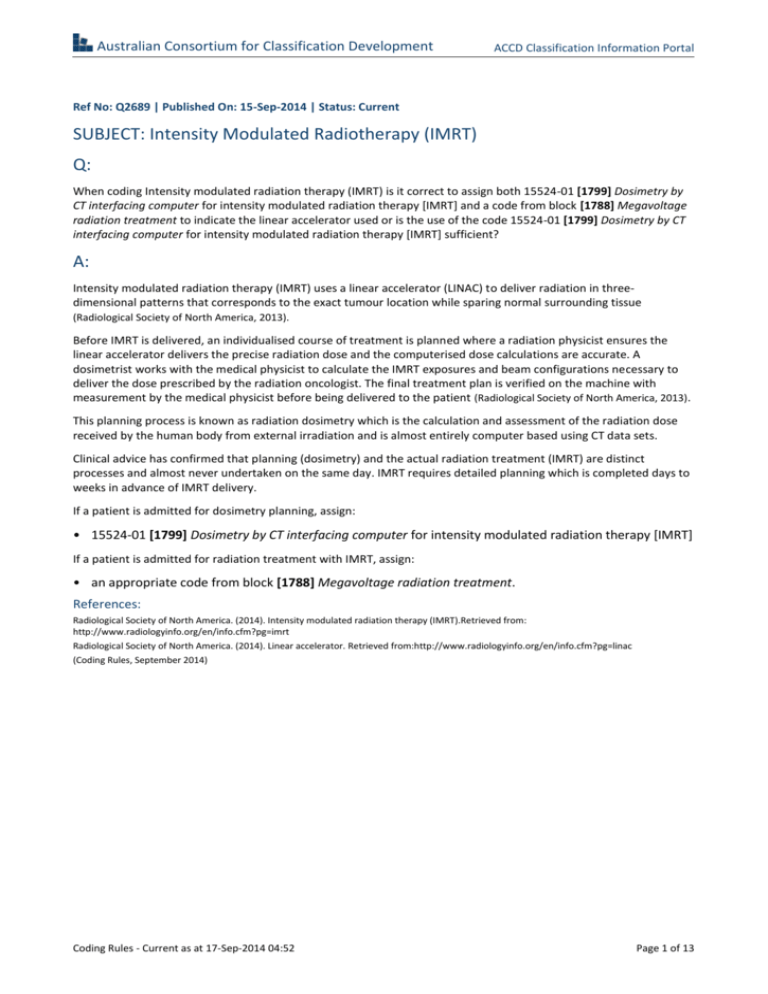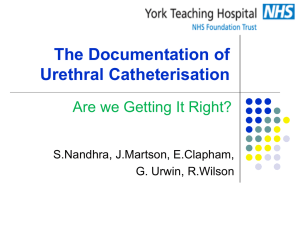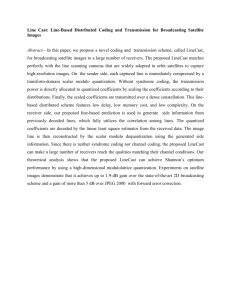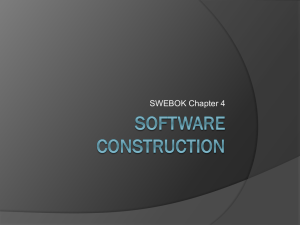Coding Rules - Current as at 17-Sep
advertisement

Australian Consortium for Classification Development ACCD Classification Information Portal Ref No: Q2689 | Published On: 15-Sep-2014 | Status: Current SUBJECT: Intensity Modulated Radiotherapy (IMRT) Q: When coding Intensity modulated radiation therapy (IMRT) is it correct to assign both 15524-01 [1799] Dosimetry by CT interfacing computer for intensity modulated radiation therapy [IMRT] and a code from block [1788] Megavoltage radiation treatment to indicate the linear accelerator used or is the use of the code 15524-01 [1799] Dosimetry by CT interfacing computer for intensity modulated radiation therapy [IMRT] sufficient? A: Intensity modulated radiation therapy (IMRT) uses a linear accelerator (LINAC) to deliver radiation in threedimensional patterns that corresponds to the exact tumour location while sparing normal surrounding tissue (Radiological Society of North America, 2013). Before IMRT is delivered, an individualised course of treatment is planned where a radiation physicist ensures the linear accelerator delivers the precise radiation dose and the computerised dose calculations are accurate. A dosimetrist works with the medical physicist to calculate the IMRT exposures and beam configurations necessary to deliver the dose prescribed by the radiation oncologist. The final treatment plan is verified on the machine with measurement by the medical physicist before being delivered to the patient (Radiological Society of North America, 2013). This planning process is known as radiation dosimetry which is the calculation and assessment of the radiation dose received by the human body from external irradiation and is almost entirely computer based using CT data sets. Clinical advice has confirmed that planning (dosimetry) and the actual radiation treatment (IMRT) are distinct processes and almost never undertaken on the same day. IMRT requires detailed planning which is completed days to weeks in advance of IMRT delivery. If a patient is admitted for dosimetry planning, assign: • 15524-01 [1799] Dosimetry by CT interfacing computer for intensity modulated radiation therapy [IMRT] If a patient is admitted for radiation treatment with IMRT, assign: • an appropriate code from block [1788] Megavoltage radiation treatment. References: Radiological Society of North America. (2014). Intensity modulated radiation therapy (IMRT).Retrieved from: http://www.radiologyinfo.org/en/info.cfm?pg=imrt Radiological Society of North America. (2014). Linear accelerator. Retrieved from:http://www.radiologyinfo.org/en/info.cfm?pg=linac (Coding Rules, September 2014) Coding Rules - Current as at 17-Sep-2014 04:52 Page 1 of 13 Australian Consortium for Classification Development ACCD Classification Information Portal Ref No: Q2750 | Published On: 15-Sep-2014 | Status: Current SUBJECT: Low grade versus noninvasive papillary urothelial carcinoma Q: Are low grade and noninvasive papillary urothelial carcinoma the same? A: Clinical advice confirms that: • the morphological descriptions ‘low grade’ and ‘noninvasive’ are not synonymous as a tumour can be both ‘low grade’ and ‘invasive’, i.e. ‘low grade’ is not equivalent to ‘noninvasive’ • low grade papillary urothelial carcinoma NOS should default to carcinoma in situ unless it is specified as ‘invasive’ wherein it is considered to be malignant. There is currently no index pathway which specifies low grade when papillary urothelial carcinoma is so described, therefore assign: D09.0 Carcinoma in situ of bladder M8130/2 Papillary Transitional Cell Carcinoma, non-invasive following the index pathway: Carcinoma … - papillary - - urothelial (M8130/3) — see also Neoplasm/bladder/malignant - - - noninvasive (M8130/2) D09.0 …. - urothelial - - papillary, noninvasive (M8130/2) D09.0 There is also no index pathway which specifies low grade invasive when papillary urothelial carcinoma is so described, therefore assign: C67.- Malignant neoplasm of bladder M8130/3 Papillary Transitional Cell Carcinoma following the index pathway: Carcinoma … - papillary - - urothelial (M8130/3) — see also Neoplasm/bladder/malignant Clinical advice also indicates that the description ‘low malignant potential’ is not synonymous with ‘low grade’ and therefore must be specifically documented before assigning the following code: Carcinoma … - papillary - - urothelial - - - of low malignant potential (M8130/1) D41.4 Indexing improvements to support this code assignment will be considered for a future edition. See also ACS 0010 General abstraction guidelines. (Coding Rules, September 2014) Coding Rules - Current as at 17-Sep-2014 04:52 Page 2 of 13 Australian Consortium for Classification Development ACCD Classification Information Portal Ref No: Q2802 | Published On: 15-Sep-2014 | Status: Current SUBJECT: Paediatric Autoimmune Neuropsychiatric Disorders (PANDAS) Q: What codes should be assigned for a principal diagnosis of PANDAS, admitted for IV Intragam? A: PANDAS is an acronym for Paediatric Autoimmune Neuropsychiatric Disorders associated with group A ß-haemolytic streptococcal infections. Children and adolescents present with rapid onset of Obsessive-Compulsive Disorder (OCD) and/or tic disorders. Treatment includes Cognitive Behavioural Therapy and pharmacotherapy with antibiotics to treat the streptococcal infection, intravenous immunoglobulin therapy and neuropsychiatric drugs. Symptoms usually persist for weeks to months with a slow, gradual improvement with some patients placed on prophylactic antibiotic therapy to prevent further streptococcal infections. There is no specific code in ICD-10-AM for Paediatric Autoimmune Neuropsychiatric Disorders (PANDAS), therefore, follow ACS 0005 Syndromes and assign codes based on the documentation in the clinical record. Diagnoses that may be assigned in these cases include: • M35.9 Systemic involvement of connective tissue, unspecified • F06.8 Other specified mental disorders due to brain damage and dysfunction and to physical disease • F42. - Obsessive-compulsive disorders • F95. - Tic disorders • B94.8 Sequelae of other specified infectious and parasitic diseases (where there is clear documentation of the association and not specified as current) OR • B95.0 Streptococcus, group A, as the cause of diseases classified to other chapters (if current). For the scenario cited where the principal diagnosis is PANDAS and the admission is for IV administration of Intragam, assign the following: M35.9 Systemic involvement of connective tissue, unspecified, as the principal diagnosis following the index pathway: Disease, diseased — see also Syndrome - autoimmune (systemic) NEC M35.9 and F06.8 Other specified mental disorders due to brain damage and dysfunction and to physical disease as an additional diagnosis following the index pathway: Disorder (of) — see also Disease - cognitive - - due to (secondary to) general medical condition F06.9 - - - mixed F06.8 References: U.S. National Institute of Mental Health (NIMH), Pediatrics and Developmental Neuroscience branch. (2012). Intramural Research Program. Retrieved from http://intramural.nimh.nih.gov/pdn/web.htm (Coding Rules, September 2014) Coding Rules - Current as at 17-Sep-2014 04:52 Page 3 of 13 Australian Consortium for Classification Development ACCD Classification Information Portal Ref No: Q2840 | Published On: 15-Sep-2014 | Status: Current SUBJECT: Malpresentation, disproportion and abnormality of maternal pelvic organs Q: When should codes from O32-O34 versus O64-O66 be assigned? A: The codes from O64-O66 are assigned when a condition classifiable to O32-O34 is first diagnosed during labour, OR requires care and/or intervention during labour because it is considered that the condition has affected the labour and/or delivery. This is consistent with the guidelines in ACS 1506 Malpresentation, disproportion and abnormality of maternal pelvic organs, the includes notes at O32-O34 and the relevant index entries. To summarise the guidelines in ACS 1506: • Where care or intervention is required due to malpresentation, disproportion or abnormality of the maternal pelvic organs before the onset of labour, assign a code from block O32-O34 (that is, known before onset of labour, care or intervention required before onset of labour, eg breech presentation diagnosed before the onset of labour and proceeds to elective caesarean section without labour). • Where the malpresentation, disproportion or abnormality of maternal pelvic organs requires care and/or intervention during labour, assign a code from blocks O64-O66 (that is, known before onset of labour, care or intervention required during labour; this includes failed trial of labour). • Where the malpresentation, disproportion or abnormality of maternal pelvic organs is first diagnosed during labour, assign a code from blocks O64-O66 (that is, not known before onset of labour). Amendments to ACS 1506 will be considered for a future edition of the Australian Coding Standards. (Coding Rules, September 2014) Coding Rules - Current as at 17-Sep-2014 04:52 Page 4 of 13 Australian Consortium for Classification Development ACCD Classification Information Portal Ref No: Q2845 | Published On: 15-Sep-2014 | Status: Current SUBJECT: Sequencing of codes for laceration with nerve and tendon injuries. Q: What is the correct sequencing of codes for a laceration involving tendon and nerve injury, but only the tendon and laceration are repaired (ie the nerve injury is noted in theatre but not repaired), should the nerve injury be coded and sequenced first, or is the nerve injury an incidental finding and the tendon injury sequenced first? A: For the scenario cited, both the tendon and nerve damage should be coded and sequencing determined by following the guidelines in ACS 1908 Laceration with nerve and tendon damage: In cases of laceration involving nerve and tendon damage, codes should be sequenced as follows: laceration with nerve damage – most severe laceration with tendon damage – moderately severe laceration uncomplicated – least severe Therefore, assign codes in the sequence below: Principal diagnosis: Injury to nerve Additional diagnoses: Injury to tendon Open wound External cause codes (Coding Rules, September 2014) Coding Rules - Current as at 17-Sep-2014 04:52 Page 5 of 13 Australian Consortium for Classification Development ACCD Classification Information Portal Ref No: Q2863 | Published On: 15-Sep-2014 | Status: Current SUBJECT: Catheterisation and cannulation in neonates Q: Is there a difference between catheterisation and cannulation in terms of ACS 1615? Does it refer only to catheterisation? A: There is no difference between these terms in ACS 1615 Specific interventions for the sick neonate; it refers to both catheterisation and cannulation. Clinical advice has confirmed that the terms catheterisation and cannulation are used interchangeably and for classification purposes they are assigned to the same code. Q: For administration of IV antibiotics or other substance in a neonate, is it the expectation that a code would automatically be assigned for the catheterisation as an additional code? A: Where the catheter is used to administer antibiotics or other substance and meets the criteria in ACS 1615, two codes would be assigned, for example documentation of IV antibiotics via scalp vein would have the following codes assigned: 13300-01 [738] 96199-02 [1920] Scalp vein catheterisation/cannulation in neonate Intravenous administration of pharmacological agent, anti-infective agent (96199-02 [1920] should only be assigned when antibiotics are given for >24 hours as per ACS 1615). Where the site of the catheter is not specified and clinical confirmation cannot be sought, then a code for the catheterisation cannot be assigned. Documentation of the site of the catheterisation is required as only the following catheterisations are to be coded as per ACS 1615: 13300-01 [738] Scalp vein catheterisation/cannulation in neonate 13300-02 [738] Umbilical vein catheterisation/cannulation in neonate 13319-00 [738] Central vein catheterisation in neonate 13303-00 [694] Umbilical artery catheterisation/cannulation in neonate See also Coding Rules (March 2014) ACS 1615 Specific interventions for the sick neonate – Catheterisation and infusions. (Coding Rules, September 2014) Coding Rules - Current as at 17-Sep-2014 04:52 Page 6 of 13 Australian Consortium for Classification Development ACCD Classification Information Portal Ref No: Q2867 | Published On: 15-Sep-2014 | Status: Current SUBJECT: ACS 0925 Hypertension and related conditions Q: Please clarify the classification guidelines in ACS 0925 Hypertension and related conditions and whether hypertension should be assigned in accordance with ACS 0002 Additional diagnoses when hypertension is present with heart or/and kidney disease but no causal relationship is documented between the conditions? A: The guidelines in ACS 0925 Hypertension and related conditions provide advice with respect to the classification of hypertension and in particular the classification of hypertension with another disease concept, pre-coordinated in a single code. The following advice is provided to clarify the content of this standard: Where a causal relationship between hypertension and heart and/or kidney disease is stated, for example, heart and/or kidney disease ‘due to hypertension’ or ‘hypertensive’ heart and/or kidney disease, assign a code from: • I11 Hypertensive heart disease for certain heart conditions (listed in I50.- or I51.4–I51.9) due to hypertension • I12 Hypertensive kidney disease for certain kidney conditions (listed in N00–N07, N18.-, N19 or N26) due to hypertension • I13 Hypertensive heart and kidney disease, when both hypertensive heart disease (I11) and hypertensive kidney disease (I12) are present. Secondary hypertension is caused by another condition such as renal artery stenosis or phaeochromocytoma. When hypertension is stated to be 'due to' or 'secondary to' other conditions, assign an appropriate code from category I15 Secondary hypertension. Where hypertension and heart or/and kidney disease are present but with no documented relationship between the conditions, assign I10 Essential (primary) hypertension when it meets the criteria in ACS 0002 Additional diagnoses. The standard has been revised for the Ninth Edition to provide clarity. (Coding Rules, September 2014) Coding Rules - Current as at 17-Sep-2014 04:52 Page 7 of 13 Australian Consortium for Classification Development ACCD Classification Information Portal Ref No: Q2877 | Published On: 15-Sep-2014 | Status: Current SUBJECT: Epiploic appendagitis Q: What is the correct code for epiploic appendagitis? A: Epiploic appendages, also known as appendices epiploicae or epiploic appendices, are small fat filled sacs, covered by the peritoneum, attached in rows along the colon (Gelrud, 2006). Epiploic appendagitis is a term that describes the swelling and inflammation of epiploic appendages, a condition mainly caused by the torsion of the epiploic appendages or spontaneous thrombosis of its draining veins, both of which compromise the vascular supply to the epiploic appendages. Occasionally epiploic appendagitis can occur secondary to a deep abdominal infection such as diverticulitis, appendicitis or pancolitis. If it is clear from the documentation that the cause of epiploic appendagitis is torsion or venous thrombosis, assign K55.0 Acute vascular disorders of intestine, by following the index pathway: Torsion - appendix epiplocae OR Thrombosis, thrombotic - intestine If there is no cause of epiploic appendagitis documented in the clinical record, and clarification is unable to be obtained from the clinician, assign K65.9 Peritonitis, unspecified, by following the index pathway: Epiploitis (see also Peritonitis) K65.9 If epiploic appendagitis is complicated by abscess formation, assign K65.0 Acute peritonitis, by following the index pathway: Abscess (embolic) (infective) (metastatic) (multiple) (pyogenic) (septic) - epiploon, epiploic K65.0 Improvements to the Alphabetic Index for epiploic appendagitis will be considered for a future edition. References: Gelrud, A., Cárdenas, A. and Chopra, A. (2006). Epiloic appendagitis. Up To Date. Retrieved from: http://mactin.com/zeno/web/zeno-med-file/Epiploic%20appendagitis.pdf Leclercq P. and Dorthu L.(2010). Epiploic appendagitis. Canadian Medical Association Journal; 182(9):939. Doi: 10.1503/cmaj.090791. (Coding Rules, September 2014) Coding Rules - Current as at 17-Sep-2014 04:52 Page 8 of 13 Australian Consortium for Classification Development ACCD Classification Information Portal Ref No: Q2883 | Published On: 15-Sep-2014 | Status: Current SUBJECT: Closure of ileostomy with resection Q: Is a separate code required for resection/excision of bowel with 30562-01 [899] Closure of ileostomy with restoration of bowel continuity, without resection as without resection is a nonessential modifier in the index? A: 30562-01 [899] Closure of ileostomy with restoration of bowel continuity, without resection includes resection of small sections (freshening) (trimming) from the end of the stoma (exteriorised bowel/doughnuts) and distal intestine prior to anastomosis. Resection/excision of intestine in excess of this freshening/trimming should be coded in addition to the closure of ileostomy code. This may occur if the diseased section of bowel was not resected prior to creation of the ileostomy or when further pathology is found during the closure procedure. Where there is no documentation of further pathology of the bowel requiring resection, a separate code for the resection should not be assigned. (Coding Rules, September 2014) Coding Rules - Current as at 17-Sep-2014 04:52 Page 9 of 13 Australian Consortium for Classification Development ACCD Classification Information Portal Ref No: Q2899 | Published On: 15-Sep-2014 | Status: Current SUBJECT: Percutaneous repair of mitral valve using MitraClip® Q: What is the correct code to assign for percutaneous mitral valve repair with the MitraClip® device? A: Percutaneous mitral valve repair with MitraClip® device is a new procedure to treat mitral regurgitation without cardiopulmonary bypass. The MitraClip® is inserted by a catheter through the femoral vein and guided to the left atrium. A transeptal puncture is performed and the device is positioned by grasping both leaflets of the mitral valve. Once the device is properly attached to the leaflets of the mitral valve the catheter is removed. This is different from percutaneous balloon mitral valvuloplasty which is performed to treat mitral stenosis. In this procedure the balloon tipped catheter is positioned in the opening of the stenosed heart valve and the balloon is inflated repeatedly to widen the valve opening. Once the valve is widened, the balloon tipped catheter is removed. Currently there is no specific code in ACHI for mitral valve repair with Mitraclip®. However a new code is being considered for a future edition. In the interim, assign 38270-02 [626] Percutaneous balloon mitral valvuloplasty following the index pathway: Valvuloplasty - heart (without valve replacement) - - mitral valve - - - percutaneous (balloon) 38270-02 [626] Although different in technique, both are percutaneous procedures performed to repair the mitral valve. Bibliographies: Abbott Vascular (2014). MitraClip Percutaneous Mitral Valve Repair System. Retrieved from: http://www.abbottvascular.com/int/mitraclip.html Adler DH (2014). Mitral valvuloplasty treatment and management. Retrieved from: http://emedicine.medscape.com/article/1533651treatment#a1133 Jilaihanssi H, Hussaini A & Kar S (2011). MitraClip: a novel percutaneous approach to mitral valve repair. Journal of Zhejiang University Science Aug 2011; 12(8): 633–637. doi: 10.1631/jzus.B1101009 Retrieved from http://www.ncbi.nlm.nih.gov/pmc/articles/PMC3150716/ Lange R and Benz M (2012), Percutaneous mitral valve repair. Retrieved from: http://emedicine.medscape.com/article/1839696overview#aw2aab6b2b2 Maisano F, Skantharaja R, Denti P, Giacomini A Ottavio P (2009). Mitral Annuloplasty. Multimedia manual of cardio-thoracic surgery Vol 2009, (0918) doi: 10.1510/mmcts.2008.003640. Retrieved from http://mmcts.oxfordjournals.org/content/2009/0918/mmcts.2008.003640.full (Coding Rules, September 2014) Coding Rules - Current as at 17-Sep-2014 04:52 Page 10 of 13 Australian Consortium for Classification Development ACCD Classification Information Portal Ref No: Q2908 | Published On: 15-Sep-2014 | Status: Current SUBJECT: Catheter based cardiac intervention with angiogram Q: Should a procedure code be assigned for cardiac catheterisation or coronary angiogram when they are performed with a catheter based cardiac intervention, e.g. percutaneous heart valve replacement? A: The term ‘cardiac catheterisation’ is a broad term for several related procedures. Cardiac catheterisation can be a purely diagnostic procedure where a catheter is inserted into heart chambers and valves to do various tests such as measuring intra-cardiac pressures, testing for cardiac shunts, and measuring cardiac output and flow. When the catheter is inserted into coronary arteries to evaluate coronary artery diseases, it is termed coronary angiogram. In recent decades, cardiac catheterisation has evolved from a purely diagnostic method into many important catheter based interventional procedures where cardiac catheterisation serves as a guiding catheter through which various instruments pass into the target site to perform specific procedures. Classification: When a cardiac catheterisation is performed alone (i.e. not in conjunction with other cardiac procedures), as a purely diagnostic procedure, assign an appropriate code from block [667] Cardiac catheterisation. When a cardiac catheterisation is performed with coronary angiogram, assign an appropriate code from block [668] Coronary angiography. When a cardiac catheter is performed in conjunction with a catheter based cardiac intervention e.g. percutaneous heart valve replacement, it is considered as an approach only, inherent in the procedure and therefore an additional code for cardiac catheterisation is not required. When a coronary angiography is performed as an additional procedure during a catheter based cardiac intervention, assign 38215-00 Coronary angiography. The ‘code also when performed coronary angiography’ instruction notes in Chapter 8 Procedures on cardiovascular system will be reviewed for a future edition of ACHI. Consideration will also be given to reviewing the codes in block [667] Cardiac catheterisation and block [668] Coronary angiography and relocating these codes to Chapter 20 Imaging services where they would be more appropriately located. (Coding Rules, September 2014) Coding Rules - Current as at 17-Sep-2014 04:52 Page 11 of 13 Australian Consortium for Classification Development ACCD Classification Information Portal Ref No: TN715 | Published On: 15-Sep-2014 | Status: Current SUBJECT: Polyp of the cervix complicating pregnancy Q: How do you code polyp of the cervix complicating pregnancy? A: Where there is documentation of observation or other obstetric care for polyp of the cervix in pregnancy (before the onset of labour), assign O34.4 Maternal care for other abnormalities of cervix by following the index pathway: Maternal care - abnormality - - cervix uteri - - - affecting - - - - pregnancy O34.4 DO NOT follow the index pathway Polyp, polypus/cervix (uteri)/affecting/pregnancy, as the WRONG code is listed. The ACCD will amend the ICD-10-AM Alphabetic Index for a future edition. (Coding Rules, September 2014) Coding Rules - Current as at 17-Sep-2014 04:52 Page 12 of 13 Australian Consortium for Classification Development ACCD Classification Information Portal Ref No: TN722 | Published On: 15-Sep-2014 | Status: Current SUBJECT: Poisoning due to helium – external cause codes Q: What external cause codes are assigned for accidental poisoning or intentional self-harm due to helium (nonmedicinal) NOS? A: The correct external cause codes to assign for poisoning due to helium (nonmedicinal) NOS are: • Accidental X47.8 Accidental poisoning by and exposure to other specified gas and vapours • Intentional self-harm – X67.8 Intentional self-poisoning by and exposure to other specified gas or vapours NOTE: The codes listed in the Table of Drugs and Chemicals; Helium (nonmedicinal) NEC/Poisoning/Accidental and Helium (nonmedicinal) NEC/Poisoning/Intentional Self-harm are invalid three character codes; the fourth character 8 is also required. Amendments to the ICD-10-AM Table of Drugs and Chemicals will be included in Ninth Edition. (Coding Rules, September 2014) Coding Rules - Current as at 17-Sep-2014 04:52 Page 13 of 13





